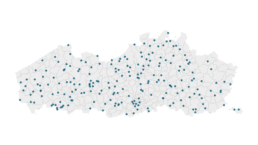Data visualization in a time of pandemic - #3: Mapping the virus
Data visualization in a time of pandemic - #3: Mapping the virus
This is a multi-chapter post!
- Chapter 1: Finding reliable data
- Chapter 2: Visualizing exponential growth
- Chapter 3: Mapping the virus
- Chapter 4: We need to talk about flattening the curve
- Chapter 5: On top of the outbreak with daunting dashboards
- Chapter 6: Viral scrollytelling

Chapter 3: Mapping the virus
A pandemic has a strong geographical factor attached to it, so obviously we are drawn to using maps to visualize how the virus is spreading. Both data visualizers and their audience simply love maps, and I personally do to. As a child, my (geographical, historical, biological, even biblical) atlases where my favourite books and I could browse through them for days. However, pretty as they may be, maps have their own pitfalls and caveats. So be prepared!

Beauty in times of despair
Let’s start with some of the most well-designed examples of maps I have encountered during my research for this chapter. The absolute winner, in my opinion, are these clean but very effective maps by the Washington Post:

Map showing the global spread of the coronavirus on March 27, 2020 (Washington Post).
To further clarify things, these maps are complemented by a simple table detailing the exact number of confirmed infections or deaths. This gives the reader the choice to look at the broader picture, dive into the detailed numbers, or both.
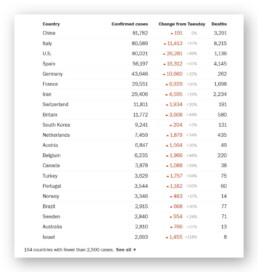
Table showing the global spread of the coronavirus on March 27, 2020 (Washington Post).
It should be noted that the BBC uses very similar, equally beautiful maps. These are examples of proportional symbol maps, or what most normal people simply call bubble maps. But why exactly do these bubble maps work so well?
Mapping issues
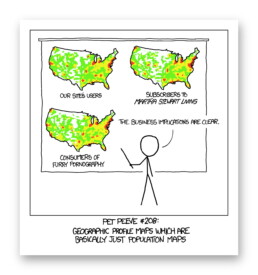

Countries and territories with confirmed cases on March 10, 2020 (ABC News).
Although somewhat helpful, such a map may say more about how connected a country is to the rest of the world, rather than showing how the virus has spread. In any case, it does not provide information about the number of cases. From this map on March 10, we cannot deduct that there was only one confirmed case in Burkina Faso, but over 10.000 in Italy, and over 80.000 in China.
A typical approach to avoid this issue are choropleth maps, a complicated name for something very simple. Blame the Greeks, choros means ‘region’ and plethos means ‘multitude’, hence the name. My scientific brain always tricks me into saying ‘chloropleth maps’, probably because it thinks about chloroplasts in plant cells. But don’t get your hopes up, there’s no connection at all — just my stupid brain. The ‘chloro-’ in chloroplasts also comes from Greek, but from chloros, ‘green’. The same origin, it turns out, as chlorine (because of its pale green color) or chloroform (which contains chlorine). But my apologies, I digress… I might have been reading too much Stephen Fry lately, who would probably love this kind of etymological exploratory ramblings.
So, a choropleth map. In such a map, regions are again colored, but the value of the color (lightness or darkness) depends on the underlying parameter, for example the number of infections in a country. In its most basic form it looks like this example by CNBC:
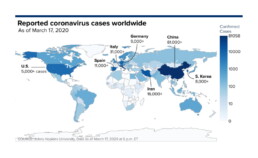
Choropleth map of reported coronavirus cases worldwide as of March 17, 2020 (CNBC).

Choropleth map of the spread of the coronavirus in China as of January 26, 2020 (CNN).
However, choropleth maps have their own unfortunate downsides and pitfalls. I will not go into much detail here, as everything was already written down excellently by ‘cartonerd’ Kenneth Field. Let me just summarize:
- choose your colors or color scheme responsibly,
- choose your categories responsibly, and
- use relative numbers to avoid population density distortion.
Or, just maybe, a bar chart might be a better choice:

🎵 The map isn’t the best way to show your data, so the bar chart is where I go. (Source: Kenneth Field)
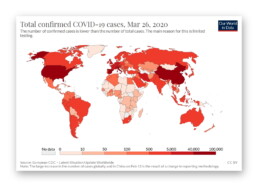
Choropleth map of the total confirmed COVID-19 cases as of March 26, 2020 (Our World in Data)
Bubble maps, such as the ones by the Washington Post shown above, avoid this trap because each nation gets its own bubble, independent of area, population, or population density. This is what makes this kind of chart so successful to map a wide range of values in a wide range of countries around the globe.
There is only one minor downside: bubbles can start overlapping each other when two neighbouring regions have very large values (or one of them has a large value while the other only a small one). Then your bubble chart might start looking like this:
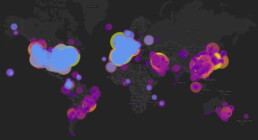
Bubble map on the nCoV-2019 Data Working Group dashboard.
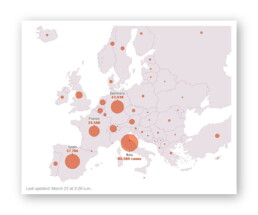
Bubble chart showing confirmed coronavirus cases throughout Europe as of March 27, 2020 (Washington Post)
The return of the table
I already hinted earlier that in some cases, a simple bar chart might be a better option than a complicated map. As Leonardo Da Vinci said: “Simplicity is the ultimate sophistication” (except that he never said that). Another simple but effective alternative might just be… a table.
Many great examples can be found, including the Washington Post ones at the beginning of this chapter, but I was particularly charmed by the Datawrapper ones by Lisa Charlotte Rost, with a clever use of color to bring a touch of optimism to this heavy subject matter:
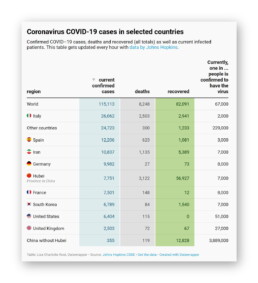
Datawrapper tables by Lisa Charlotte Rost (screenshot: March 18, 2020).
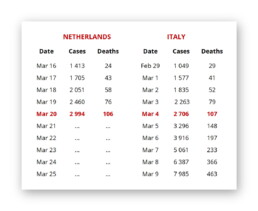
Table comparing the number of infections and deaths between the Netherlands and Italy.

Same data (well, more or less), different story.
Also, differences in age distribution among the population have an impact on the death rate, so it’s rarely a good idea to blindly start comparing different columns or rows with each other, without thinking things through. Remember: if creating panic is your goal, you will always find some data somewhere presented in such a way that you can do so.
There are many, mány more amazing things you can do with tables, also in coronavirus times, but that will be something for another chapter!
Nightmare maps


BBC, by the way, has written an interesting story on an old map showing air travel routes going viral (pun not intended) and causing panic because of poor journalism, such as this badly chosen tweet by the Sun:
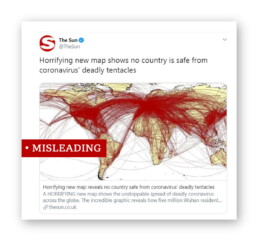
Journalism: you’re doing it wrong.
Finally, if you would ever think about using a pie chart as an alternative to a map… just don’t:
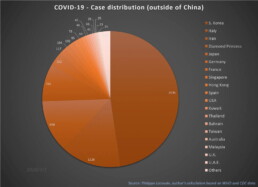
I like pies — Pecan pie! Frangipane pie! Key lime pie! — but not this kind, thanks. (Source: European Scientist)
This is a multi-chapter blog post!
Continue reading:
- Chapter 1: Finding reliable data
- Chapter 2: Visualizing exponential growth
- Chapter 3: Mapping the virus
- Chapter 4: We need to talk about flattening the curve
- Chapter 5: On top of the outbreak with daunting dashboards
- Chapter 6: Viral scrollytelling
For all your comments, suggestions, errors, links and additional information, you can contact me at koen@baryon.be or via Twitter at @koen_vde.
Disclaimer: I am not a medical doctor or a virologist. I am a physicist running my own business (Baryon) focused on information design.
Read more:
Vreemde plaatsnamen in Vlaanderen
Iedereen kent wellicht 'Kontich' en 'Reet', maar in Vlaanderen hebben we nog veel meer merkwaardige, onverwachte, en vaak grappige plaatsnamen. Heb je bijvoorbeeld ooit al gehoord van Buitenland, Dikkebus, of Grote Homo?
9 June 2024
Small multiples can save your chart
When you're dealing with a chart that has too much information on it, the most straightforward advice to follow is: break it down into multiple charts, each with less information on them. A powerful example of this is a so-called small multiple approach.
5 September 2023
Data visualization podcasts 2023
At Baryon, we’re huge fans of podcasts! Data visualization podcasts are a great way to stay up to date on the latest trends and techniques in data visualization.
4 September 2023
Can you use Excel to create a powerful chart?
Spreadsheet tools such as Microsoft Excel or Numbers might not be the first thing on your mind when considering data visualization tools, but they can be pretty solid choices to build data visuals. Don’t let anyone convince you that using Excel to create data visuals is unprofessional.
9 January 2023
Choosing the right font for your data visual
Fonts evoke emotions: there are very sophisticated fonts, playful fonts, attention-grabbing fonts, and elegant handwritten fonts. Using the wrong type of font can have a lot of impact. In data visualization the implications of typography are mainly focused on readability. Labels and annotations can easily become so small they get hard to read. Above all else, we should choose a font which is readable at small sizes.
2 January 2023
Three roles of colour in a data visual
Colour is one of the most crucial tools we have to turn a normal chart into a powerful chart with a clear message, a chart which tells a story rather than simply presenting the information.
26 December 2022
We are really into visual communication!
Every now and then we send out a newsletter with latest work, handpicked inspirational infographics, must-read blog posts, upcoming dates for workshops and presentations, and links to useful tools and tips. Leave your email address here and we’ll add you to our mailing list of awesome people!

Data visualization in a time of pandemic - #2: Visualizing exponential growth
Data visualization in a time of pandemic - #2: Visualizing exponential growth
This is a multi-chapter post!
- Chapter 1: Finding reliable data
- Chapter 2: Visualizing exponential growth
- Chapter 3: Mapping the virus
- Chapter 4: We need to talk about flattening the curve
- Chapter 5: On top of the outbreak with daunting dashboards
- Chapter 6: Viral scrollytelling

Chapter 2: Visualizing exponential growth
Let me warn you in advance: this will probably be the most theoretical and mathematical chapter of this entire blog post. We’ll have a short look at the underlying scientific principles of a pandemic and analyze how this translates to visualizing data. If that’s not really your thing, it’s totally okay to just look at the pictures and then skip to the next chapter! 😉

A mathematical approach to pandemics
A pandemic disease is a complex thing to model. We live in a world of nearly 8 billion people in over 230 countries, connected with each other through 100.000 daily plane flights and an equally mind-boggling number of train and bus rides. Nevertheless, many experts have attempted to model the spread of a disease in a closely-connected world.
For example, professor biostatistics Kurt Barbé models the pandemic spread through a first order differential equation, resulting in the number of active infections following a Gaussian curve, with its typical bell shaped profile:
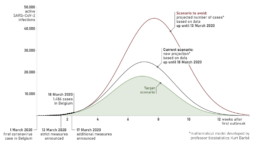
Different scenarios for the coronavirus spread in Belgium, as modeled by professor Kurt Barbé (March 18, 2020).
This is a simplified but not unrealistic model. For example, if we look at the number of active COVID-19 cases in China, where the peak has nearly passed, we can see that the Gaussian profile is a pretty good approximation (the sudden increase in the number of cases on February 13 is the result of a change in reporting methodology).
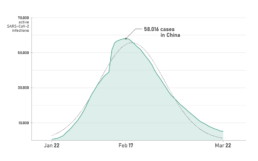
Evolution of the number of active SARS-CoV-2 infections in China.
We can assume that if the number of active infections follows a Gaussian-shaped profile, the number of new infections and the number of deaths will also follow Gaussian profiles. If we plot cumulative data, such as the total number of confirmed cases or the total number of deaths, this will follow an S-shaped cumulative function profile — the integral of the Gaussian function. For example, the total number of deaths by COVID-19 in China looks like this:

Evolution of the total number of COVID-19-related deaths in China.
Crucially, at the start of such peaks and S-curves, the shape will follow an approximately exponential profile, with the number of infections or the number of deaths doubling every few days at a constant acceleration. That’s the reason why we are seeing so many graphs appearing which show the number of infections on a logarithmic scale — such as the one below by John Burn-Murdoch for the Financial Times. On such a log-scale, exponential growth will appear as straight lines. The steeper the line, the more rapidly the growth is accelerating.

Financial Times graphic by John Burn-Murdoch on the growth of the number of coronavirus cases in different countries.
Which brings us to the following point of discussion: is using a logarithmic scale a good idea?
Logarithmic scales: yes or no?
Using logarithmic scales in a data visualization is sometimes frowned upon, as it has some obvious drawbacks:
- Requires additional explanation when communicating towards a general public, which might not be familiar with this type of plot.
- Not a good way at all to compare values with each other.
However, there are specific cases where the use of logarithmic scales might be justified: when the underlying mechanism behind the data is multiplicative in nature, leading to (more or less) exponential growth. This is exactly the case in the early outbreak stage of a contagious disease (when only a minor fraction of the population is infected).
For example, a patient infected with smallpox will infect on average 5 other people. This is the basic reproduction number of the infection. These 5 people will — on average — each infect 5 new people, or 25 in total. These 25 will infect 5 x 25 = 125, and so on, and so on. For the novel coronavirus, early estimates of the basic reproduction number range between 1.4 and 3.9, which is higher than a seasonal flu (0.9–2.1), but much lower than for example measles (12–18).
The basic reproduction number is influenced by many different factors which cannot be controled, such as the incubation time and the infectiousness of the disease. However, it also depends on the number of susceptible people that affected patients are in contact with. This is the main reasoning behind social distancing measures to ‘flatten the curve’ (more about flattening the curve visuals in a later chapter): the lower the number of people an infected patient comes in contact with, the lower the reproduction number and the slower the disease will spread through the population.
As many countries are currently in the early exponential growth phase of the epidemic, and taking measures to reduce the reproduction number, this is an appropriate opportunity to plot the number of infections (and the number of deaths) on a logarithmic scale. It enables us to quickly evaluate in which countries measures are more effective and the disease is spreading less rapidly, such as Japan or Singapore:

Number of confirmed coronavirus cases per country, on a linear-logarithmic scale.

Basic reproduction number of well-known infectious diseases. (Source: Wikipedia)
As an additional benefit, linear-logarithmic plots like these can educate the general public about the exponential nature of the disease in its early stage. This avoids more sensation-oriented headlines such as ‘More new infections today than ever before!’. While this is true, it doesn’t have to mean things are getting out of control. Everything might be entirely as expected, or even improving. As Hans Rosling notes in his bestseller Factfulness (if you haven’t read it, do it immediately!): things can be both better and bad.
A final note on logarithmic scales before I shut up about it and we can move on to more exciting things. As the infection continuous to spread, a growing fraction of the population will become either already infected, or immune when they have been infected in the past but survived. Also, vaccines can be developed, or increasingly strict measures of social distancing and quarantine can be enforced. In practice, this means the effective reproduction number will drop, the exponential growth will start to decelerate and the number of infections will reach a peak and start dropping again. When this happens, the usefulness of logarithmic scales has reached its end.

Even Bill agrees.
But aren't absolute numbers meaningless?
By now, I have created many different visuals related to the novel coronavirus, and one of the most pervasive comments concerns the use of absolute numbers. Many people argue that we cannot directly compare numbers between countries without correcting for the population count. This sounds relatively convincing — how on earth can we compare the number of deaths between a tiny country such as Belgium, and a massive nation like China?
However, this is a multifaceted question without a definitive answer. Let me list the major arguments for both approaches:
We must use relative numbers, because:
- The number of infections and deaths in a country depends on the size of that country.
- We want to evaluate the stress the pandemic will put on a country’s healthcare system, which can usually only support a certain fraction of the population being infected.
We must use absolute numbers, because:
- The rate at which a disease spreads depends on the population density and the level of social distancing, but has nothing to do with the population number. In this regard, country borders are pretty arbitrary ways of grouping people, anyway.
- Relative numbers will create pretty meaningless ‘outliers’ for some very small countries.
- Should we plot the relative or the absolute number of infections?
In my impression, most data visualizers follow the approach of using absolute numbers when plotting the total number of infections. The above-mentioned John Burn-Murdoch also agrees:
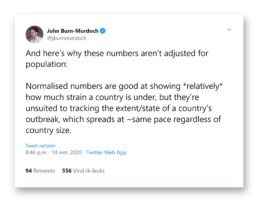
Thanks for backing me up here, John!
Nevertheless, using relative numbers can be very useful for other use cases such as:
- Showing the number of tests performed per capita.
- Showing the available number of doctors, hospital beds, intensive care beds,… per capita.
- Comparing how hard different countries are currently hit by the crisis.
For example, comparing the number of COVID-19 tests performed by country in absolute and relative numbers reveals some interesting insights:
Nevertheless, using relative numbers can be very useful for other use cases such as:
- Showing the number of tests performed per capita.
- Showing the available number of doctors, hospital beds, intensive care beds,… per capita.
- Comparing how hard different countries are currently hit by the crisis.
For example, comparing the number of COVID-19 tests performed by country in absolute and relative numbers reveals some interesting insights:
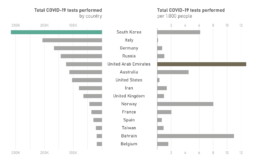
Number of tests performed per country and per 1.000 inhabitants. (Source: Our World in Data)
This is a multi-chapter blog post!
Continue reading:
- Chapter 1: Finding reliable data
- Chapter 2: Visualizing exponential growth
- Chapter 3: Mapping the virus
- Chapter 4: We need to talk about flattening the curve
- Chapter 5: On top of the outbreak with daunting dashboards
- Chapter 6: Viral scrollytelling
For all your comments, suggestions, errors, links and additional information, you can contact me at koen@baryon.be or via Twitter at @koen_vde.
Disclaimer: I am not a medical doctor or a virologist. I am a physicist running my own business (Baryon) focused on information design.
Read more:
Vreemde plaatsnamen in Vlaanderen
Iedereen kent wellicht 'Kontich' en 'Reet', maar in Vlaanderen hebben we nog veel meer merkwaardige, onverwachte, en vaak grappige plaatsnamen. Heb je bijvoorbeeld ooit al gehoord van Buitenland, Dikkebus, of Grote Homo?
9 June 2024
Small multiples can save your chart
When you're dealing with a chart that has too much information on it, the most straightforward advice to follow is: break it down into multiple charts, each with less information on them. A powerful example of this is a so-called small multiple approach.
5 September 2023
Data visualization podcasts 2023
At Baryon, we’re huge fans of podcasts! Data visualization podcasts are a great way to stay up to date on the latest trends and techniques in data visualization.
4 September 2023
Can you use Excel to create a powerful chart?
Spreadsheet tools such as Microsoft Excel or Numbers might not be the first thing on your mind when considering data visualization tools, but they can be pretty solid choices to build data visuals. Don’t let anyone convince you that using Excel to create data visuals is unprofessional.
9 January 2023
Choosing the right font for your data visual
Fonts evoke emotions: there are very sophisticated fonts, playful fonts, attention-grabbing fonts, and elegant handwritten fonts. Using the wrong type of font can have a lot of impact. In data visualization the implications of typography are mainly focused on readability. Labels and annotations can easily become so small they get hard to read. Above all else, we should choose a font which is readable at small sizes.
2 January 2023
Three roles of colour in a data visual
Colour is one of the most crucial tools we have to turn a normal chart into a powerful chart with a clear message, a chart which tells a story rather than simply presenting the information.
26 December 2022
We are really into visual communication!
Every now and then we send out a newsletter with latest work, handpicked inspirational infographics, must-read blog posts, upcoming dates for workshops and presentations, and links to useful tools and tips. Leave your email address here and we’ll add you to our mailing list of awesome people!

Data visualization in a time of pandemic - #1: Finding reliable data
Data visualization in a time of pandemic - #1: Finding reliable data
Oh no! Not another coronavirus post! Yes, I know, we are bombarded by pandemic content these days. My apologies for creating even more. However, it is not my purpose to bore you with more of the same, or to confuse you with pointless details. Being a passionate information designer I decided to have a look at good and bad practices in COVID-19 related content from a data visualization point of view. I hope this will be a useful and inspiring overview.
This is a multi-chapter post!
- Chapter 1: Finding reliable data
- Chapter 2: Visualizing exponential growth
- Chapter 3: Mapping the virus
- Chapter 4: We need to talk about flattening the curve
- Chapter 5: On top of the outbreak with daunting dashboards
- Chapter 6: Viral scrollytelling
We are living in remarkable times. The novel coronavirus is causing an epidemic spreading with a velocity we have never experienced before. Busy long-distance air and rail traffic have made it impossible to contain the virus after its first outbreak in China. For the first time our modern world is confronted with a pandemic of this scale and magnitude, and our healthcare systems are being put to the test.
But in fighting these challenges, the world has never been as united as today. Research teams across the globe are working together to develop cures, social media are used extensively to keep everyone informed, and innovative companies are coming up with solutions to keep people at home and the virus at bay. Technology plays a crucial role in this fight.
As an information designer, I am specifically fascinated by the efforts of the data science and visualization communities. The newest developments in these fields are put to use to turn a complex and rapidly changing topic into easy-to-communicate visuals. In only a matter of days, nearly everyone is familiar with the ‘flatten the curve’ visuals, or Washington Post’s animations on the impact of social distancing.
In this post, we will explore some of the marvelous ways people around the world are using data visualization in the fight against the novel coronavirus.

Chapter 1: Finding reliable data
As noted by Edward Tufte, excellent graphics consist of complex ideas communicated with clarity, precision, and efficiency. At the core of a good data visual, therefore, lies accurate data. So before we start diving into coronavirus graphs, we will first take a brief stop at trustworthy data sources.
Sources of reliable data
There are currently three important places where one can obtain reliable and relatively complete aggregate data about the Coronavirus epidemic:
- World Health Organization
The World Health Organization publishes daily Situation reports detailing the number of confirmed cases and deaths per country. They also provide a Situation dashboard which is updated three times per day.

WHO Novel Coronavirus Situation Dashboard
- John Hopkins University
Researchers at John Hopkins University also maintain a dashboard providing an overview of the current number of cases, deaths and recoveries on a per country basis. The underlying data is made freely available through GitHub.

John Hopkins University Coronavirus Dashboard
- European Center for Disease Control and Prevention
The ECDC publishes daily statistics on the pandemic for the entire country (despite its name!). Data is published daily at 1 p.m. CET and is presented on a situation update page.
- Our World in Data
The team of Max Roser collects and combines all available data and information about the epidemic on a single page. This excellent summary provides interactive charts on many different topics ranging from the number of cases to symptoms, incubation period and fatality rate. Each chart comes with a downloadable data set.
Accuracy of data
Collecting and aggregating global data in a rapidly changing environment, such as during a pandemic, is obviously very tricky. None of the above datasets should therefore be considered an ‘absolute truth’, as minor errors are bound to happen. Such errors can be related to reporting difficulties or contradicting sources, or differences and shifts in methodology, but can also be due to minor errors such as typos.
As an example, let us compare the three datasets above for the total number of confirmed cases in Belgium (between March 1 and March 19) with the official numbers communicated by the Belgian government (which can be found here).
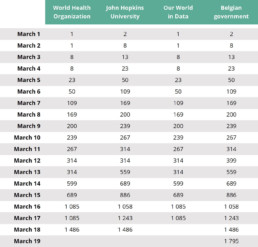
Comparison between different data sources of the reported total number of confirmed COVID-19 cases in Belgium between March 1 and March 19, 2020.
Immediately we can note some discrepancies. The John Hopkins University data follows the government data most closely, with an exception on March 12 where for some reason the number was not updated.
The two other datasets (WHO and Our World in Data) appear to lag behind by one day up until March 16, possibly because WHO Situation reports are published at specific timings which don’t match accurately with government reporting timings. Also, these datasets miss the same update as the John Hopkins numbers (from 314 to 399 cases), they were not updated on March 17, and they appear to have a typing error in them (1.085 cases on March 16, while the official government number was 1.058).
Finally, Our World in Data temporarily stopped updating beyond March 17 because WHO shifted their reporting window: up until Situation report 57 the observed 24-hour time window ended at 10 a.m. CET, since then it ends at midnight. This causes a small overlap making it difficult to accurately compare data and analyze trends.
- Update March 23: Note that Our World in Data stopped relying on WHO data as they found too many errors in the daily Situation reports. Instead, they switched to data provided by the ECDC.
In summary, John Hopkins University data most closely matches official government numbers (for Belgium).
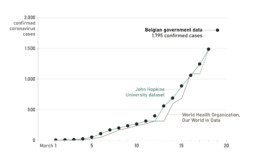
Total number of confirmed COVID-19 cases in Belgium in March 2020, comparison between different sources.
Finding more data sources
If you are looking for alternative data sources, direct reports by governments, or data on specific regions or cities, I highly recommend the data section of the Coronavirus Tech Handbook, a crowdsourced document bringing together all the tools, datasets and visualizations on this topic.
The sheer amount of available data can make it a bit overwhelming, especially taking into account that new numbers are being announced almost constantly. When in doubt, I would advise to stick to the four most complete data sources listed above.
This is a multi-chapter blog post!
Continue reading:
- Chapter 1: Finding reliable data
- Chapter 2: Visualizing exponential growth
- Chapter 3: Mapping the virus
- Chapter 4: We need to talk about flattening the curve
- Chapter 5: On top of the outbreak with daunting dashboards
- Chapter 6: Viral scrollytelling
For all your comments, suggestions, errors, links and additional information, you can contact me at koen@baryon.be or via Twitter at @koen_vde.
Disclaimer: I am not a medical doctor or a virologist. I am a physicist running my own business (Baryon) focused on information design.
Read more:
Vreemde plaatsnamen in Vlaanderen
Iedereen kent wellicht 'Kontich' en 'Reet', maar in Vlaanderen hebben we nog veel meer merkwaardige, onverwachte, en vaak grappige plaatsnamen. Heb je bijvoorbeeld ooit al gehoord van Buitenland, Dikkebus, of Grote Homo?
9 June 2024
Small multiples can save your chart
When you're dealing with a chart that has too much information on it, the most straightforward advice to follow is: break it down into multiple charts, each with less information on them. A powerful example of this is a so-called small multiple approach.
5 September 2023
Data visualization podcasts 2023
At Baryon, we’re huge fans of podcasts! Data visualization podcasts are a great way to stay up to date on the latest trends and techniques in data visualization.
4 September 2023
Can you use Excel to create a powerful chart?
Spreadsheet tools such as Microsoft Excel or Numbers might not be the first thing on your mind when considering data visualization tools, but they can be pretty solid choices to build data visuals. Don’t let anyone convince you that using Excel to create data visuals is unprofessional.
9 January 2023
Choosing the right font for your data visual
Fonts evoke emotions: there are very sophisticated fonts, playful fonts, attention-grabbing fonts, and elegant handwritten fonts. Using the wrong type of font can have a lot of impact. In data visualization the implications of typography are mainly focused on readability. Labels and annotations can easily become so small they get hard to read. Above all else, we should choose a font which is readable at small sizes.
2 January 2023
Three roles of colour in a data visual
Colour is one of the most crucial tools we have to turn a normal chart into a powerful chart with a clear message, a chart which tells a story rather than simply presenting the information.
26 December 2022
We are really into visual communication!
Every now and then we send out a newsletter with latest work, handpicked inspirational infographics, must-read blog posts, upcoming dates for workshops and presentations, and links to useful tools and tips. Leave your email address here and we’ll add you to our mailing list of awesome people!


